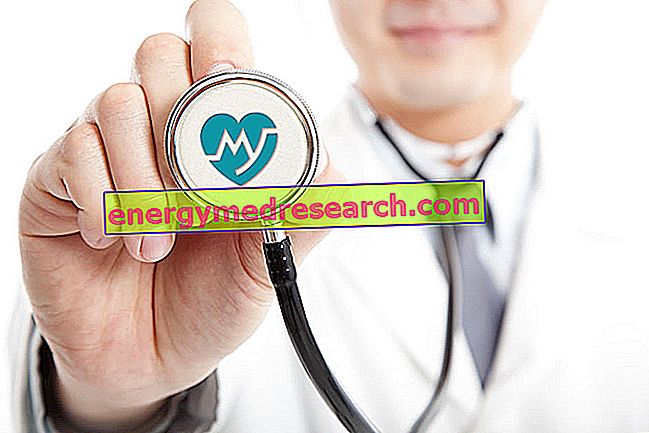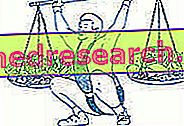Pregnancy and Salmon
Salmon in pregnancy: introduction
The relevance of salmon in pregnancy is often the subject of discussion.

This disagreement originates above all from the fact that the fish is marketed in various forms of preservation and processing, destined to very different preparations. Salmon is available raw and frozen or thawed, fresh, smoked or canned.
In pregnancy, certain raw and canned foods are strongly discouraged; on the other hand, very often these products have such important nutritional characteristics that they cannot be neglected in any way.
So: can you eat salmon in pregnancy? It depends, sometimes yes and others not. Let's go into more detail.
What is salmon?
Salmon is a bone fish. In human nutrition it is considered a "fishery product" that falls under the "First Fundamental Group of Foods". From the considerable energy supply, however, salmon is appreciated due to its nutritional value and potential health benefits. Below we will better understand why.
There are various types of salmon. The most widespread in Europe is Atlantic salmon (called Norwegian or Scottish), belonging to the Salmonidae family, Genus Salmo and salar species. In evident and progressive demographic decline in the natural habitat (but not as much as the "chinook" or "real" of Canada - Oncorhynchus tshawytscha ), this salmon can be successfully reproduced in extensive, intensive or hyperintensive breeding. Its commercial availability therefore does not depend only on fishing.
Did you know that ...
Salmon is a diadromous - anadromous fish, meaning that it lives mainly in the sea and only goes up the rivers to reproduce. When the eggs hatch, the young salmon descend the freshwater streams towards the salt water where they will stand for years awaiting complete sexual maturation.
Salmon lends itself to many types of culinary preparations, some simple and others more complex. The only cooking method that is usually advised against for the preparation of salmon is frying, as it tends to alter the chemical characteristics of the food (especially the integrity of "good fats").
In the kitchen, salmon can be used to make appetizers, first courses and dishes, depending on the type of raw material. Salmon is excellent defrosted, natural and raw (carpaccio, sushi, tartare, etc.), smoked and raw, cooked in pasta sauces (natural or smoked), naturally cut into slices and cooked in the oven or grilled, in a pan etc.
As anticipated the salmon has nutritional characteristics that many would call excellent. Its good reputation has gradually increased its consumption in the general population. As part of the collective diet, salmon can be useful but not irreplaceable. It can also have contraindications such as, for example, those of a hygienic type in the diet during pregnancy.
Nutritional Features
Nutrients of salmon in pregnancy: are they good?
Before wondering if it is correct to eat salmon in pregnancy, we should ask ourselves if it is a useful food in the diet. Yes, salmon is a product with good nutritional characteristics. However, we must not let ourselves be convinced by those who advertise it as an irreplaceable food; later we will understand better why.
His qualities include:
- Richness of "partially essential" omega 3 fatty acids: eicosapentaenoic acid (EPA) and docosahexaenoic acid (DHA). They are metabolically more active than the essential alpha linolenic acid (ALA), contained in foods of vegetable origin (oilseeds, starchy seed germs, extraction oils, etc.). EPA and DHA perform numerous functions: they constitute cell membranes, allow the development of the brain and eyes in the fetus and in the child, reduce the general inflammatory state and exert benefits on many metabolic pathologies (hypertension, hypertriglyceridemia, type 2 diabetes mellitus lesions etc. ), on brain activity in old age, mood, etc. In gestations characterized by the onset or aggravation of primary arterial hypertension, ensuring an adequate intake of omega 3 can help improve health (provided it does not derive from smoked or canned salmon, rich in hypertensive sodium) .
- Richness of vitamin D (more precisely D3): also called colecalciferol, this fat-soluble nutrient is abundant in both meat and salmon liver. It is essential for bone metabolism, guaranteeing the growth of the skeleton in the fetus and reaching the peak of bone mass in the development phase. It also performs an important immunomodulatory function.
- Richness of proteins with high biological value: they are those that contain all the essential amino acids in the right quantities and proportions. Necessary for the health maintenance of any human organism, they are quite important (but rarely lacking) even during pregnancy for the development of the fetus .
- Salmon raised in the sea contains iodine: necessary for maintaining thyroid health, iodine is a mineral potentially lacking in the nutrition of the general population. Any serious nutritional deficiency can compromise the development of the fetus ; for this reason, choosing the type of salmon to buy, it would be better to prefer the one bred at sea.
- Retinol equivalents (RAE): the rosy color of salmon is naturally formed by astaxanthin, a carotenoid or provitamin A originally contained in tiny phytoplankton algae. Eaten from the crustaceans that are part of the diet of the salmon, this micro algae allow the passage of the pigment from the base until almost to the vertex of the food chain. Wild or farmed salmon fed with plankton (krill) have a naturally rosy color; those fed with feed instead, are integrated with carotenoids of different types. The main function of RAE is antioxidant and vitamin A precursor (indispensable, for example, for visual function). Very rarely, carotenoids and vitamin A are deficient in nutrition during pregnancy.
Nutritional controversies of salmon in pregnancy
Often we get so distracted from the merits of this food that we forget to take into consideration even the less desirable nutritional factors. For example, not everyone knows that salmon also provides cholesterol and saturated fat. A portion of this fish provides up to 17% of the maximum daily cholesterol for a healthy person (max 300 mg / day) and up to 25% for one with hypercholesterolemia (max 200 mg / day).
Furthermore, the concentration of polyunsaturated fats, including ( but not limited to ) omega 3, is quantitatively identical to that of saturated fats (which tend to increase cholesterolemia). The saturated / polyunsaturated ratio is therefore adequate but certainly not "surprising".
Smoked salmon and canned salmon (in brine or in oil) are also rich in sodium, coming from the salt (NaCl) used to increase storage. Although rich in omega 3 (EPA and DHA), potentially hypotensive, smoked salmon and canned salmon are inadequate for the diet against primary sodium-sensitive arterial hypertension (especially during pregnancy).
Is salmon necessary in pregnancy?
No, salmon is not a necessary product for the expectant mother. But we must not forget that during pregnancy it is very important to continue to eat the fishery products 2-3 times a week and, more generally, we must not absolutely eliminate the first and second fundamental food group (meat, fish and eggs ; milk and derivatives).
The salmon can easily be replaced with other foods of the same type; particularly suitable are blue fish rich in omega 3 (EPA and DHA), vitamin D and iodine, such as, for example: sardine, mackerel, bonito, anchovies, alaccia, needlefish, lanzardo, horse mackerel, leccia, greenhouse, lampuga, alletterato, tombarello etc. Instead, they are less valuable from a nutritional point of view, poorly digestible, richer in cholesterol and potentially allergenic to crustaceans (shrimps, shrimp, prawns, scampi, lobster, lobster, spider crab, crab spider, crabs, etc.) and molluscs, especially bivalves (mussels, oysters, clams, razor clams, cockles, cockles, sea truffles, etc.).
The average portion of fresh or thawed salmon is about 100 g, not more than 150 g. The frequency of consumption should ultimately be sporadic, alternating with other fishery products.
For other nutritional information on salmon we recommend reading the dedicated article: Salmon.
Safety
Hygienic food requirements: is salmon suitable in pregnancy?
From a hygienic point of view, the consumption of salmon in pregnancy could have contraindications.
It is known that during pregnancy, contracting certain foodborne illnesses (zoonoses or parasites, food poisoning, infections, poisoning, etc.) can seriously harm the health of the unborn child. We must then deal with any contamination from pollutants. We proceed with order; among the most feared diseases we recall toxoplasmosis and listeriosis.
Toxoplasmosis in pregnancy: does salmon increase the risk?
Toxoplasmosis is a parasitic foodborne disease. Caused by Toxoplasma gondii (protozoan), if it occurs during pregnancy, in just under 1/3 of cases it passes the placenta reaching the fetus. The severity of the zoonosis increases with the months of gestation, with greater probability that the child suffers "congenital toxoplasmosis", showing fetal deformations (especially neurological), premature birth, abortion and death. Toxoplasmosis is taken only once (except for immunosuppressed patients). If the protozoan has already come into contact with the woman's body previously, this develops antibodies that prevent its systemic action. It is mainly transmitted via faecal gold from feces of carrier animals (containing cysts) and cross-contamination, for example through unwashed vegetables and fruits, drinking non-drinkable water, putting hands in the mouth after doing gardening or cleaning up. cat litter. Sensitive to heat, it dies even only at pasteurization and freezing temperatures (see below).
The only forms of salmon that can carry toxoplasmosis are those that are raw and secondarily contaminated, due to cross-contamination and fecal gold, since fish is not a creature that can host this parasite. The heat of cooking or pasteurization (approximately over 70 ° C) effectively eliminates the Toxoplasma gondii present in raw foods without leaving a trace. On the other hand, if cooked foods come into contact with the pathogen later, regardless of how long they are stored, they can be a cause of toxoplasmosis. On the contrary, by freezing contaminated products (raw or cooked) up to - 20 ° C, protozoa can be effectively eliminated; unfortunately the Toxoplasma gondii is not the only pathogen harmful in pregnancy, which is why during gestation it could be inadvisable to eat raw salmon, especially outside the home.
Listeriosis in pregnancy: does salmon increase the risk?
Listeriosis is an infectious-bacterial foodborne disease. Caused by Listeria monocytogenes (rarely by L. ivanovii and L. grayi ), listeriosis becomes dangerous during septicemia (from the intestine it passes to the bloodstream). The repercussions can therefore be of a general type (for example brain infection) but also specific, with involvement of the vagina and uterus up to the fetus. The symptoms, which are almost null at first, frankly become evident in the third month of pregnancy and last 7-10 days. The most serious complications of listeriosis are spontaneous abortion, premature birth and lethal newborn infection. Just under 1/3 of cases of severe listeriosis concern pregnant women; 22% of severe gestating forms cause abortion or neonatal death (mothers tend to survive). Listeria, ubiquitous in soil and water, is prolific in poorly preserved and raw foods, especially unpasteurized milk, muffled and blue cheese (from unpasteurized milk), raw or cooked and preserved fish and meat, smoked fish, etc. Cross-contamination from raw, unhealthy foods to cooked and preserved foods also plays a fundamental role (even in the fridge). Sensitive to heat, it dies even only at pasteurization temperature.
Salmon can be infected by listeria in various ways. Being present in breeding water, listeria can affect this fish especially during improper slaughter or due to inadequate procedures during storage and storage. If it involves raw fish, the listeria does not die either with smoking, or with freezing; moreover, it seems that at refrigerator temperatures and with high concentrations of sodium (salting, brine), it is still able to reproduce effectively. It is above all because of the listeria that in pregnancy it is necessary to avoid the raw salmon, even if smoked, and also the cooked and preserved for more than a day in the refrigerator. The consumption of homemade preserves based on cooked salmon is also not recommended.
Other salmon pathogens
In the salmon pathogens can multiply whose infection is NOT directly responsible for abortion, fetal death, malformations or mental retardation, but which can however be indirectly dangerous for the pregnancy.
Some examples are:
- Salmonella, Coliformi, Staphylococci: they are three large groups of pathogens that can give rise to food poisoning. They are mainly diffused through the fecal-oral route, cross-contamination, diffusion of saliva dependent operator. They mainly concern foods that are slaughtered inadequately or from non-certified origin, cooked inadequately and poorly preserved. Some also produce spores and toxins.
- Botulinum: it is a very dangerous bacterium that spreads especially in preserves. Can relate to canned salmon produced at home. His neurotoxins give rise to botulinum syndrome; very dangerous, it interferes with the transmission of the nervous impulse and can be deadly. It is sensitive to cooking but it is advisable to avoid "suspicious" foods
- Anisakis: pathogenic worm that can nest and perforate the human intestine requiring surgery. It dies with the lowering of temperature or with freezing (see the article dedicated to the temperatures and times required) and with pasteurization or cooking. Does not perish with smoking, drying and marinating.
Salmon pollutants: are they dangerous?
To be sure, salmon is not among the most polluting fish. On the other hand, like all other sea creatures, it is not exempt from some environmental contamination. Fortunately, remaining medium-sized, the salmon does not act as a "reservoir" like, for example, tuna, swordfish and sharks (verdesca, palombo, emery etc).
Is mercury in salmon dangerous in pregnancy?
Among the most formidable contaminants that can affect salmon, especially those raised in the sea, we mention mercury. This heavy metal is now sadly known for its poisonous effect on the central nervous system which can also affect the fetus during pregnancy, causing serious side effects. Fortunately, the levels of mercury in salmon are largely normal.
Are dioxins in salmon dangerous in pregnancy?
Another very widespread and much feared pollutant is that of dioxins and the like. Residues of the degradation of plastic materials (waste), these molecules can have a very negative impact on the health of consumers; the fruit of conception, as always, is particularly sensitive to anomalous concentrations of pollutants that can have teratogenic effects (malformations). Also in this case the salmon does not raise serious concerns and there are still no cases of accumulation of dioxins in its meat.
Salmon and histamine: is it harmful in pregnancy?
Histamine is a product of the degradation of the amino acid histidine which, in the human body, acts as a chemical mediator of inflammation and a neurotransmitter; it is typical of allergic reactions. Histamine can also be formed inside foods due to the metabolism of some microorganisms or independently; it is therefore abundant in preserved foods (for example smoked salmon), especially in those characterized by a certain bacterial or fungal growth.
An excess of histamine produces a rather evident and annoying symptomatology. There is a category of people, called intolerant, that reacts hypersensitively even to normal histamine concentrations (sometimes even if produced at an endogenous level). Considering that, during gestation, the bodily reactions that involve the release of histamine can increase (for example dermatitis and eczema, in 1% to 18% of cases), it is certainly good practice to significantly limit the consumption of smoked salmon and all histamine rich (or precursor) foods (especially in case of pre-existing hypersensitivity).
Conclusions
Can you eat salmon in pregnancy?
It is certainly possible to eat salmon during pregnancy, provided that some simple recommendations are respected:
- Consume only salmon from certified farms (aquaculture)
- Raw salmon should not be stored for long periods in the refrigerator. It may be a good idea, after purchase, to maintain an adequate temperature (or so-called cold chain) for transport and cook it within a day
- The salmon must always be cooked, regardless of whether it has been chilled and kept frozen, salted, smoked, etc.
- Cooked salmon MUST NOT be eaten after storage for more than 24 hours
- Eventually thawed salmon (a procedure to be carried out strictly in the refrigerator or in the microwave), cannot be frozen again raw
- Better to avoid freezing cooked salmon; in the event, it is good to remember to thaw it in the microwave and regenerate it at temperatures above 70-75 ° C
- In the presence of histamine reactions or histamine intolerance, avoid smoked salmon and canned salmon.



